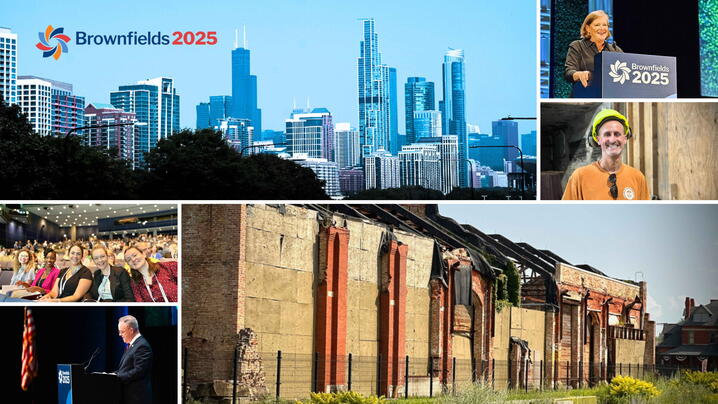
Every community has them: overlooked lots, shuttered factories, and forgotten buildings. They sit quietly in plain sight. However, with the right vision and collaboration, these brownfield sites have the potential to become some of a community's most valued assets.
"Brownfields are really an archeological dig. It's the layers of our economy," said Julia D. Novak, ICMA-CM, CEO and executive director of ICMA, speaking at the 2025 National Brownfields Training Conference in Chicago. Novak emphasizes that for local governments, brownfield redevelopment is more than cleanup—it is about creating tangible benefits for the community. "It's about having an impact on what's happening right around you ... their conversion into housing, businesses, public parks, and health clinics can be dramatic enough for a movie script."
The possibilities multiply when local governments, agencies, and other community partners come together. John Busterud, nominee for assistant administrator at the U.S. EPA Office of Land and Emergency Management, explained, "By listening to and talking with each other, we can get all the ideas out and onto the table. I view that as cooperative federalism and cross-agency partnership in action."
That spirit of collaboration was clear throughout the conference, where innovators from across the country explored how underused sites could fuel economic mobility, resilience, and livability.
For many communities, the opportunities may be hiding in plain sight. Here are four strategies local governments can use to revitalize and transform brownfields.
1. Identify Revitalization Priorities and Start with a Vision
Every transformation begins with a vision, but vision alone is not enough. Local governments need a way to determine which projects can move forward and will deliver the greatest benefits. Much of that comes down to funding. That means aligning community goals with funders' priorities, using data and storytelling to strengthen proposals, and understanding which programs are getting funded and why.
Workshop speaker Matt Ward, CEO of Sustainable Strategies DC, explained that the most impactful revitalization projects occur where three elements meet: a clear vision and need, solutions and priorities that fit the community, and the capacity and partners to deliver.
This approach ensures that resources go to projects that create measurable value, from job creation to public health improvements.
2. Build Partnerships that Drive Opportunity
Once priorities are set, partnerships turn them into action. Revitalization can create local jobs, attract new businesses and tourism, and build community wealth. But no single organization makes all that happen alone.
The strongest projects bring together government agencies, nonprofits, developers, and local businesses early in the process. These partnerships foster trust, align goals, and do the work to ensure the outcomes reflect community needs.
Early collaboration also strengthens funding applications, streamlines implementation, and moves projects to deliver lasting benefits.
3. Design for Synergy: Multi-Use Solutions
Some of the most innovative revitalization projects do more than one thing at once. They combine uses in ways that multiply benefits and strengthen community resilience.
Examples showcased at the 2025 National Brownfields Training Conference included solar farms paired with agriculture.
United Agrivoltaics, for example, partners with farmers and solar developers to place sheep on solar sites for vegetation management while keeping the land in agricultural use. This multi-use approach produces energy, supports farm income, and strengthens local economies and food access—all on the same footprint.
4. Preserve History to Shape the Future
Some brownfield sites carry history worth protecting. Redevelopment that honors the past can create destinations that educate, inspire, and enrich community identity.
The Pullman State Historic Site in Chicago, winner of the 2025 National Phoenix Award, is one such example. Once home to the Pullman Palace Car Company, the site played a pivotal role in American labor history and urban planning.
Today, it is a national historic park and active work site that preserves Chicago's industrial legacy, celebrates local cultural contributions, and welcomes visitors nationwide. Pullman demonstrates how revitalization can turn a dormant industrial relic into a nationally recognized treasure.
A clear vision with strategic priorities, strong partnerships, innovative land use, and appreciation for history can catalyze transformation and shape the future. The potential is already there, waiting to be unlocked.

See the 2025 National Brownfields Training Conference Photo Album Here
Join Us at the 2025 ICMA Annual Conference
If community revitalization is part of your work, the ICMA Annual Conference is where you'll find ideas, connections, and resources to make your next project a success. Since 1914, the International City/County Management Association (ICMA) has brought together thousands of local government leaders and public sector partners to tackle communities' toughest challenges.
This October 25-29, join us in Tampa, Florida, for keynotes, workshops, and networking that can help turn your next vision into reality.
If you liked the National Brownfields Training Conference (cohosted by ICMA), check out these ICMA Annual Conference sessions:
- The Revitalization of City Centers: Strategies for Growth and Transformation of Downtowns – Insights from the city of San Antonio into reimagining and reinvesting in core districts.
- A Unique Approach to Economic Development/Redevelopment Through Pinellas County's Employment Sites Program – Learn how targeted site development drives job growth.
- Explore the Tampa Riverwalk – A firsthand look at a waterfront revitalization success story.
- Tampa Historic District: Ybor City – Experience how historic preservation fuels cultural and economic vitality.
Register and learn more about the 2025 ICMA Annual Conference.
New, Reduced Membership Dues
A new, reduced dues rate is available for CAOs/ACAOs, along with additional discounts for those in smaller communities, has been implemented. Learn more and be sure to join or renew today!
